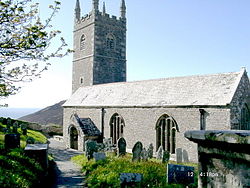Morwenstow
| Morwenstow | |
| Cornwall | |
|---|---|
 St Morwenna and St John the Baptist, Morwenstow | |
| Location | |
| Grid reference: | SS205152 |
| Location: | 50°54’31"N, 4°33’12"W |
| Data | |
| Postcode: | EX23 |
| Local Government | |
| Council: | Cornwall |
Morwenstow is a tiny, beautifully isolated village in the very north of Cornwall. The parish is near the coast, about six miles north of Bude. It is within the 'Cornwall Area of Outstanding Natural Beauty', as is almost a third of the county.
Morwenstow is the most northerly parish in Cornwall. As well as the churchtown (a hamlet called Crosstown), other settlements in the parish include Shop, Woodford, Gooseham, Eastcott, Woolley and West Youlstone. The parish population at the 2011 census was 837.
Morwenstow parish is bounded to the north and east by parishes in Devon, to the south by Kilkhampton parish and to the west by the Atlantic.[1] The River Tamar has its source at a spring on Woolley Moor,[2] at 50°55’25"N, 4°27’44"W, which is in the parish near the border with Devon.
Morwenstow is the one-time home of the eccentric vicar and poet Robert Stephen Hawker (1803–1875), the writer of Cornwall's anthem The Song of the Western Men, also known as Trelawny. Hawker is also credited with reviving the custom of Harvest Festivals.
Parish church
The parish church is dedicated to St John the Baptist and St Morwenna and is of the Norman period. The vicarage was built for Hawker and has chimneys in the form of the towers of various churches associated with him.
The nearby coast is hazardous to shipping and the corpses of drowned sailors were laid out in the churchyard and then buried. Hawker buried over forty who were washed up within the parish boundaries.
One of the memorials in the churchyard was the white figurehead of the "Caledonia", a 200-ton ship which sank on the perilous rocks of Higher Sharpnose in 1842. The captain and crew are buried in the churchyard. In 2004 the figurehead was removed for conservation, with the intention of placing a replica in the churchyard and the conserved original inside the church.[3]
About the village
A path leads from the church and down to the cliff edge, where the National Trust's smallest building, "Hawker's Hut," is built into the face of the cliff overlooking the sea out towards the island of Lundy. Here, Hawker spent many hours in contemplation, writing poetry, and smoking his opium pipe. He also entertained guests here, including Alfred Tennyson and Charles Kingsley.[4] Much of the coastline from here to Bude has been acquired by the National Trust.[5]
The manor of Stanbury in the parish is the birthplace of John Stanberry, Bishop of Hereford, who was made first Provost at Eton College by King Henry VI. Sir William Adams, the oculist who founded the West of England Eye Infirmary in Exeter was also born at Stanbury. The manor house was built in the 16th century.
Nearby Tonacombe Manor has been described as the perfect Tudor manor.
A striking example of curved and contorted stratified rocks occurs at Stanbury Creek. Dark cliffs of folded, interbedded shales and mudstones form wave-cut platforms.
GCHQ Bude, a satellite ground station stands on the cliffs of Cleave and its array of dishes is visible for miles around.
Literary associations
Morwenstow and its surroundings feature heavily in the plot of the mystery thriller novel Set in Stone (1999) by the novelist Robert Goddard.
The Wreck at Sharpnose Point by Jeremy Seal (June 2003) is a novel based on the wrecking of the 'Caledonia' (first published in New York, 2001 ISBN 0-330-37465-6).
Outside links
| ("Wikimedia Commons" has material about Morwenstow) |
References
- ↑ Information on Morwenstow from GENUKI
- ↑ Neale, John. Discovering the River Tamar. Amberley. 2010.
- ↑ [1] Article on the "Caledonia"
- ↑ Clegg, David (2005) Cornwall & the Isles of Scilly: the complete guide. Leicester: Matador; pp. 46-47
- ↑ Bude to Morwenstow